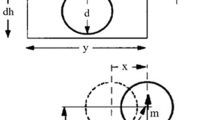Abstract
Chattering due to vibrations on the machine tool shaft and control of the transmitted torque are both a concern in precision machining. Hence, a magnetorheological fluid clutch–brake, also acting as a rotary damper could be a promising solution. Permanent magnets are used to mechanically activate the clutch thus offering simplicity and reliability in operation. The viscosity of the magnetorheological fluid changes with the action of the magnetic field thus allowing to tune the transmitted torque. Moreover, the fluid adds damping in the system. In this paper, a computational magnetohydrodynamics model has been realized in order to numerically investigate and visualize the torque transmission under different rotational velocities when submitted to magnetic flux. The model was validated with experimental data from the literature. Results showed that because the permanent magnets have a limited flux intensity, the torque transmission is only efficient at lower rotational velocities.











Similar content being viewed by others
References
ANSYS FLUENT Theory Guide (2011), p 42
Binyet E, Chang JY (2018) Simulation of MRF activated clutch–brake using permanent magnets. In: Asia-Pacific magnetic recording conference
Bucchi F, Forte P, Frendo F (2013) A magnetorheological clutch for efficient automotive auxiliary device actuation. Frattura ed Integrità Strutturale 23:62–74
Bucchi F, Forte P, Frendo F, Musolino A, Rizzo R (2014) A fail-safe magnetorheological clutch excited by permanent magnets for the disengagement of automotive auxiliaries. J Intell Mater Syst, Struct, p 25
FLUENT 6.3 Magnetohydrodynamics (MHD) module manual (2006)
Li WH, Du H (2003) Design and experimental evaluation of a magnetorheological brake. Int J Adv Manuf Technol 21:508–515
Mitsoulis E (2007) Flows of viscoplastic materials: models and computations. In: Binding DM, Hudson NE, Keunings R (eds) Rheology reviews. British Society of Rheology, London, pp 135–178
Munoa J, Beudaert X, Dombovari Z, Altintas Y, Budak E, Brecher C, Stepan G (2016) Chatter suppression techniques in metal cutting. CIRP Ann 65(2):785–808
Nguyen QH, Choi SB (2012) Selection of magnetorheological brake types via optimal design considering maximum torque and constrained volume. Smart Mater, Struct, p 21
Pranoto T, Nagaya K (2005) Development on 2DOF-type and Rotary-type shock absorber damper using MRF and their efficiencies. J Mater Process Technol 161:146–150
Rizzo R, Musolino A, Bucchi F, Forte P, Frendo F (2015) A multi-gap magnetorheological clutch with permanent magnet. Smart Mater Struct 24:393–400
Sajedipour D, Behbahani S, Tabatabaei SMK (2010) Mechatronic modelling and control of a lathe machine equipped with a MR damper for chatter suppression. In: 8th IEEE international conference on control and automation
Smythe WR (1989) Static and dynamic electricity. Taylor & Francis, Bristol. ISBN 0-89116-916-4
Sukhwani VK, Hirani H (2008) Design, development, and performance evaluation of high-speed magnetorheological brakes. Proc Inst Mech Eng Part L J Mater Des Appl 222:73–82
Acknowledgements
The authors are grateful to Ministry of Science and Technology of Taiwan with Grants MOST 107-2218-E-007-036 and MOST 105-2923-E-007-001-MY3 for supporting this research.
Author information
Authors and Affiliations
Corresponding author
Additional information
Publisher's Note
Springer Nature remains neutral with regard to jurisdictional claims in published maps and institutional affiliations.
Rights and permissions
About this article
Cite this article
Binyet, E.M., Chang, JY. Magnetohydrodynamics modelling of a permanent magnets activated MRF clutch–brake. Microsyst Technol 26, 3451–3457 (2020). https://doi.org/10.1007/s00542-020-04910-w
Received:
Accepted:
Published:
Issue Date:
DOI: https://doi.org/10.1007/s00542-020-04910-w




